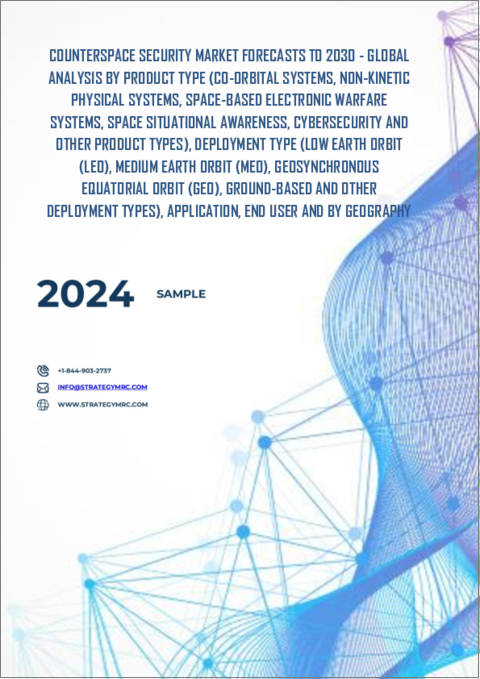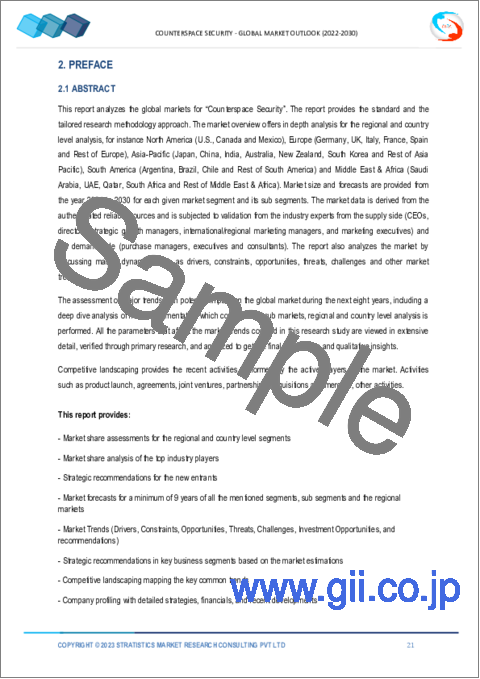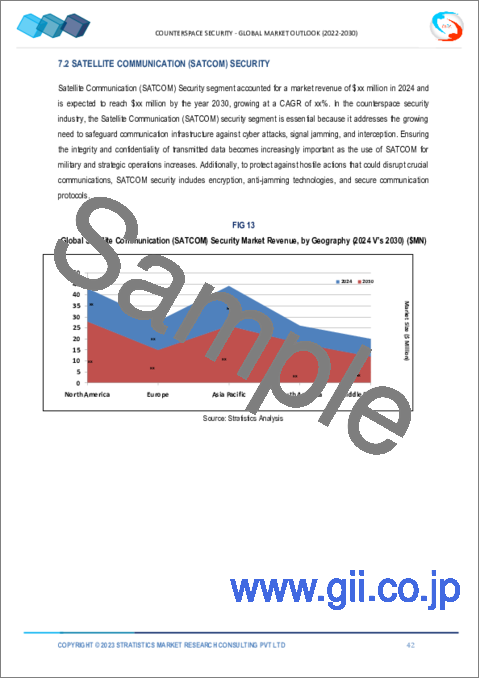|
|
市場調査レポート
商品コード
1454004
対宇宙セキュリティ市場の2030年までの予測: 製品タイプ、展開タイプ、用途、エンドユーザー、地域別の世界分析Counterspace Security Market Forecasts to 2030 - Global Analysis By Product Type, Deployment Type (Low Earth Orbit, Medium Earth Orbit, Geosynchronous Equatorial Orbit, Ground-Based and Other Deployment Types), Application, End User and by Geography |
||||||
カスタマイズ可能
|
|||||||
| 対宇宙セキュリティ市場の2030年までの予測: 製品タイプ、展開タイプ、用途、エンドユーザー、地域別の世界分析 |
|
出版日: 2024年03月03日
発行: Stratistics Market Research Consulting
ページ情報: 英文 200+ Pages
納期: 2~3営業日
|
全表示
- 概要
- 図表
- 目次
Stratistics MRCによると、世界の対宇宙セキュリティ市場は2023年に75億米ドルを占め、予測期間中のCAGRは10.56%で成長し、2030年には151億米ドルに達すると予想されています。
対宇宙セキュリティという用語は、重要な宇宙ベースのインフラや資産を、意図的な混乱や攻撃などの可能性のある危険から安全に保つために使用される防衛・保護戦略を表しています。通信、航行、気象監視、その他の重要なタスクのための衛星への世界の依存が拡大し続けているため、強力な対宇宙セキュリティの必要性が高まっています。さらに、この分野には、宇宙システムに対する可能性のあるリスクを特定し、阻止し、軽減するように設計された様々な戦術、ツール、規制が含まれます。宇宙活動の妨害は世界中に影響を及ぼす可能性があるため、対宇宙セキュリティの取り組みには国際協力が頻繁に関与しています。
ISSRA(International Space Security and Resilience Association)によれば、宇宙インフラに対する脅威が進化する中で、宇宙資産の保護と回復力を確保することは必須です。ISSRAは、強固な対宇宙セキュリティを確立し、重要な宇宙能力を保護するための国際協力を促進するための国家間の協力的努力の必要性を強調しています。
高まる衛星への依存
通信、気象観測、国家安全保障、科学研究など、衛星への依存度はかつてないほど高まっています。社会が相互接続を強め、データへの依存度が高まるにつれて、宇宙ベースの資産に対する潜在的な混乱や攻撃に対する脆弱性が増大するため、高度な対宇宙セキュリティ・ソリューションが強く求められています。さらに、衛星技術が現代生活にますます浸透していることから、これらの重要なインフラを保護するための予防措置が緊急に必要であることが浮き彫りになっています。
費用とリソースの制限
大きな障害の1つは、最先端の対宇宙セキュリティ技術を開発、実装、維持するためのコストが高いことです。リソースの制約により、政府や民間組織が最先端のソリューションに必要な投資を行うことができない場合があります。さらに、宇宙空間のセキュリティ対策市場における継続的な課題の1つは、セキュリティ対策を改善する必要性と、それに伴う財政的現実とのバランスを見つけることです。
商業宇宙における活動の活発化
衛星を利用したサービスや宇宙探査への民間企業の参入が増加していることから、宇宙空間のセキュリティ対策に利益をもたらす可能性があります。さらに、通信、地球観測、その他の用途で衛星を打ち上げる民間企業が増えるにつれて、これらの資産を保護するための強力なセキュリティ対策の必要性が高まっています。最先端の対宇宙セキュリティ・ソリューションを開発・実施するためには、政府と民間事業体が協力して相互に有益な機会を創出することができます。
対衛星(ASAT)能力の向上
対宇宙空間の安全保障は、ASAT能力の普及によって深刻な脅威にさらされています。より多くの国が対衛星技術を開発し、テストするにつれて、意図的な干渉や衛星破壊の可能性が高まっています。さらに、直接的な物理的攻撃からサイバーや電子戦までを含むASAT能力の多様性は、起こりうる脅威に対する防御をより困難にし、細部への継続的な注意と柔軟なセキュリティ対策が必要となります。
COVID-19の影響:
COVID-19の世界的流行は、多くの市場に多大な影響を与え、消費者行動を変化させ、サプライチェーンを根底から覆し、経済活動に影響を及ぼしています。デジタル・サービス、ヘルスケア・テクノロジー、リモート・ワークなどのセクターが急成長を遂げる一方で、旅行、ホスピタリティ、伝統的な小売業などの業界は深刻な落ち込みを見せた。さらに、パンデミックによって、デジタル・コミュニケーション・ツール、遠隔医療サービス、eコマースへの依存度が高まった。政府による封鎖、社会的距離政策、経済の不確実性も消費者の購買習慣に影響を及ぼし、その影響は市場セグメントによって異なります。
予測期間中、宇宙状況認識(Space Situational Awareness)分野が最大になる見込み
宇宙状況認識(SSA)分野が最大のシェアを占める。衛星、スペースデブリ、可能性のある脅威の追跡など、宇宙活動を監視し理解することに関しては、SSAは不可欠です。このカテゴリーには、異常な活動や安全保障上の脅威の可能性を認識できるように、地球軌道上の物体に関する最新のデータを提供することを目的とした装置やフレームワークが含まれます。さらに、効果的な対宇宙セキュリティは、宇宙状況認識の上に構築され、オペレーターが可能性のある脅威を迅速に特定し、評価し、無力化することを可能にします。宇宙環境を完全に把握するために、衛星ベースのセンサー、レーダー、地上の望遠鏡を組み合わせる。
衛星通信(SATCOM)セキュリティ分野は予測期間中最も高いCAGRが見込まれます。
衛星通信(SATCOM)セキュリティ分野は、CAGRが最も高くなると予測されています。衛星通信は、重要なインフラ運用、国家安全保障、世界の接続性にとって不可欠であるため、SATCOMシステムを潜在的な脅威から保護することは今や極めて重要です。SATCOMセキュリティとは、衛星通信リンク、地上局、関連ネットワークに対する悪意ある活動、サイバー攻撃、干渉に対する防御策の展開を指します。さらに、軍事・民生アプリケーションの衛星通信への依存度が高まるにつれ、高度なSATCOMセキュリティ・ソリューションの必要性が急速に高まっています。
最大のシェアを持つ地域:
現在、北米が最大のシェアを占め、カウンタースペース・セキュリティ市場をリードしています。この地域の優位性は、著名な業界参加者の顕著な存在、洗練された技術的熟練度、宇宙ベースのインフラと国家安全保障に向けた多額の配分に起因します。特に米国は、宇宙探査、軍事衛星の利用、最先端の対宇宙安全保障技術の開発において主導権を握ってきました。さらに北米は、政府の強力なイニシアチブ、防衛予算、重要な宇宙資産の保護に重点を置くことで、対対宇宙セキュリティ市場をリードしています。
CAGRが最も高い地域:
対宇宙セキュリティ市場は、アジア太平洋地域で最も高いCAGRで成長しています。この地域のダイナミックな拡大は、宇宙技術への投資の増加、宇宙活動の活発化、宇宙関連の脅威に対する意識の高まりによって促進されています。さらに、アジア太平洋諸国は軍事・民生用の宇宙開発を積極的に進めており、これが最先端の対宇宙セキュリティの必要性を煽っています。各国政府は現在、地政学的環境や地域的な宇宙探査イニシアチブの増加により、重要な宇宙資産の保護を優先しています。
無料カスタマイズサービス:
本レポートをご購読のお客様には、以下の無料カスタマイズオプションのいずれかをご利用いただけます:
- 企業プロファイル
- 追加市場プレイヤーの包括的プロファイリング(3社まで)
- 主要企業のSWOT分析(3社まで)
- 地域セグメンテーション
- 顧客の関心に応じた主要国の市場推計・予測・CAGR(注:フィージビリティチェックによる)
- 競合ベンチマーキング
- 製品ポートフォリオ、地理的プレゼンス、戦略的提携に基づく主要企業のベンチマーキング
目次
第1章 エグゼクティブサマリー
第2章 序文
- 概要
- ステークホルダー
- 調査範囲
- 調査手法
- データマイニング
- データ分析
- データ検証
- 調査アプローチ
- 調査ソース
- 1次調査ソース
- 2次調査ソース
- 前提条件
第3章 市場動向分析
- 促進要因
- 抑制要因
- 機会
- 脅威
- 製品分析
- 用途分析
- 新興市場
- 新型コロナウイルス感染症(COVID-19)の影響
第4章 ポーターのファイブフォース分析
- 供給企業の交渉力
- 買い手の交渉力
- 代替品の脅威
- 新規参入業者の脅威
- 競争企業間の敵対関係
第5章 世界の対宇宙セキュリティ市場:製品タイプ別
- 共同軌道システム
- 非運動物理システム
- 高出力レーザー
- 高出力電子レンジ
- 宇宙ベースの電子戦システム
- ジャマー
- アンテナ
- レーダー警報受信機(RWR)
- 宇宙状況認識
- レーダー
- 光学
- レーザー測距
- シグナルインテリジェンス(SIGINT)
- サイバーセキュリティ
- その他の製品タイプ
第6章 世界の対宇宙セキュリティ市場:展開タイプ別
- 地球低軌道(LEO)
- 中地球軌道(MEO)
- 静止赤道軌道(GEO)
- 地上ベース
- その他の展開タイプ
第7章 世界の対宇宙セキュリティ市場:用途別
- 衛星通信(SATCOM)のセキュリティ
- 衛星ナビゲーションのセキュリティ
- 地球観測セキュリティ
- 宇宙ベースの早期警報システム
- その他の用途
第8章 世界の対宇宙セキュリティ市場:エンドユーザー別
- 商業
- 軍隊
- その他のエンドユーザー
第9章 世界の対宇宙セキュリティ市場:地域別
- 北米
- 米国
- カナダ
- メキシコ
- 欧州
- ドイツ
- 英国
- イタリア
- フランス
- スペイン
- その他欧州
- アジア太平洋地域
- 日本
- 中国
- インド
- オーストラリア
- ニュージーランド
- 韓国
- その他アジア太平洋地域
- 南米
- アルゼンチン
- ブラジル
- チリ
- その他南米
- 中東とアフリカ
- サウジアラビア
- アラブ首長国連邦
- カタール
- 南アフリカ
- その他中東とアフリカ
第10章 主な発展
- 契約、パートナーシップ、コラボレーション、合弁事業
- 買収と合併
- 新製品の発売
- 事業拡大
- その他の主要戦略
第11章 企業プロファイル
- General Dynamics Mission Systems, Inc.
- Honeywell Aerospace
- Collins Aerospace
- Airbus SE
- Lockheed Martin Corporation.
- BAE Systems PLC
- Mitsubishi Electric Corporation
- Cobham PLC
- Elbit Systems Ltd.
- Northrop Grumman Corporation
- Leonardo S.p.A.
- Israel Aerospace Industries Ltd.
- Thales Group
- Raytheon Company
- L3Harris Technologies.
- Rafael Advanced Defense Systems Ltd
List of Tables
- Table 1 Global Counterspace Security Market Outlook, By Region (2021-2030) ($MN)
- Table 2 Global Counterspace Security Market Outlook, By Product Type (2021-2030) ($MN)
- Table 3 Global Counterspace Security Market Outlook, By Co-orbital Systems (2021-2030) ($MN)
- Table 4 Global Counterspace Security Market Outlook, By Non-kinetic Physical Systems (2021-2030) ($MN)
- Table 5 Global Counterspace Security Market Outlook, By High-Powered Laser (2021-2030) ($MN)
- Table 6 Global Counterspace Security Market Outlook, By High-Powered Microwave (2021-2030) ($MN)
- Table 7 Global Counterspace Security Market Outlook, By Space-based Electronic Warfare Systems (2021-2030) ($MN)
- Table 8 Global Counterspace Security Market Outlook, By Jammers (2021-2030) ($MN)
- Table 9 Global Counterspace Security Market Outlook, By Antennas (2021-2030) ($MN)
- Table 10 Global Counterspace Security Market Outlook, By Radar Warning Receivers (RWR) (2021-2030) ($MN)
- Table 11 Global Counterspace Security Market Outlook, By Space Situational Awareness (2021-2030) ($MN)
- Table 12 Global Counterspace Security Market Outlook, By Radars (2021-2030) ($MN)
- Table 13 Global Counterspace Security Market Outlook, By Optics (2021-2030) ($MN)
- Table 14 Global Counterspace Security Market Outlook, By Laser Ranging (2021-2030) ($MN)
- Table 15 Global Counterspace Security Market Outlook, By Signal Intelligence (SIGINT) (2021-2030) ($MN)
- Table 16 Global Counterspace Security Market Outlook, By Cybersecurity (2021-2030) ($MN)
- Table 17 Global Counterspace Security Market Outlook, By Other Product Types (2021-2030) ($MN)
- Table 18 Global Counterspace Security Market Outlook, By Deployment Type (2021-2030) ($MN)
- Table 19 Global Counterspace Security Market Outlook, By Low Earth Orbit (LEO) (2021-2030) ($MN)
- Table 20 Global Counterspace Security Market Outlook, By Medium Earth Orbit (MEO) (2021-2030) ($MN)
- Table 21 Global Counterspace Security Market Outlook, By Geosynchronous Equatorial Orbit (GEO) (2021-2030) ($MN)
- Table 22 Global Counterspace Security Market Outlook, By Ground-Based (2021-2030) ($MN)
- Table 23 Global Counterspace Security Market Outlook, By Other Deployment Types (2021-2030) ($MN)
- Table 24 Global Counterspace Security Market Outlook, By Application (2021-2030) ($MN)
- Table 25 Global Counterspace Security Market Outlook, By Satellite Communication (SATCOM) Security (2021-2030) ($MN)
- Table 26 Global Counterspace Security Market Outlook, By Satellite Navigation Security (2021-2030) ($MN)
- Table 27 Global Counterspace Security Market Outlook, By Earth Observation Security (2021-2030) ($MN)
- Table 28 Global Counterspace Security Market Outlook, By Space-based Early Warning Systems (2021-2030) ($MN)
- Table 29 Global Counterspace Security Market Outlook, By Other Applications (2021-2030) ($MN)
- Table 30 Global Counterspace Security Market Outlook, By End User (2021-2030) ($MN)
- Table 31 Global Counterspace Security Market Outlook, By Commercial (2021-2030) ($MN)
- Table 32 Global Counterspace Security Market Outlook, By Military (2021-2030) ($MN)
- Table 33 Global Counterspace Security Market Outlook, By Other End Users (2021-2030) ($MN)
Note: Tables for North America, Europe, APAC, South America, and Middle East & Africa Regions are also represented in the same manner as above.
According to Stratistics MRC, the Global Counterspace Security Market is accounted for $7.5 billion in 2023 and is expected to reach $15.1 billion by 2030 growing at a CAGR of 10.56% during the forecast period. The term counterspace security describes the defense and protection strategies used to keep vital space-based infrastructure and assets safe from possible dangers like deliberate disruptions or attacks. The need for strong counterspace security is growing as the world's reliance on satellites for communication, navigation, weather monitoring, and other critical tasks keeps expanding. Moreover, this field includes a range of tactics, tools, and regulations designed to identify, stop, and lessen possible risks to space systems. Since disruptions to space activities can have worldwide repercussions, international cooperation is frequently involved in counterspace security efforts.
According to the International Space Security and Resilience Association (ISSRA), ensuring the protection and resilience of space assets is imperative in the face of evolving threats to space-based infrastructure. ISSRA emphasizes the need for collaborative efforts among nations to establish robust counterspace security measures and foster international cooperation in safeguarding critical space capabilities.
Market Dynamics:
Driver:
Increasing reliance on satellites
The globe has never been more dependent on satellites for an increasing range of applications, including telecommunication, weather monitoring, national security, and scientific research. Advanced counterspace security solutions are in high demand as societies grow more interconnected and dependent on data, increasing their vulnerability to potential disruptions or attacks on space-based assets. Furthermore, the increasing pervasiveness of satellite technology in modern life highlights the urgent need for preventative actions to safeguard these essential infrastructures.
Restraint:
Expenses and resource limitations
One major obstacle is the high cost of developing, implementing, and maintaining cutting-edge counterspace security technologies. Resource limitations may prevent governments and private organizations from making the necessary investments in cutting-edge solutions. Additionally, one of the ongoing challenges in the counterspace security market is finding a balance between the need to improve security measures and the associated financial realities.
Opportunity:
Increased activity in commercial space
Profitable prospects for counterspace security are presented by the growing participation of private enterprises in satellite-based services and space exploration. Furthermore, there is a growing need for strong security measures to safeguard these assets as more commercial entities launch satellites for communication, Earth observation, and other uses. In order to develop and implement cutting-edge counterspace security solutions, governments and private entities can collaborate to create mutually beneficial opportunities.
Threat:
Rising capabilities for anti-satellite (ASAT)
The security of counterspace is seriously threatened by the spread of ASAT capabilities. The likelihood of deliberate interference or satellite destruction rises as more nations create and test anti-satellite technologies. Moreover, the variety of ASAT capabilities, which include everything from direct physical assaults to cyber and electronic warfare, makes it more difficult to defend against possible threats and necessitates ongoing attention to detail and flexible security measures.
Covid-19 Impact:
The global COVID-19 pandemic has had a profound effect on a number of markets, altering consumer behavior, upending supply chains, and affecting economic activity. While sectors like digital services, healthcare technology, and remote work saw faster growth, industries like travel, hospitality, and traditional retail saw severe downturns. Furthermore, the pandemic led to a greater reliance on digital communication tools, telehealth services, and e-commerce. Lockdowns enforced by the government, social distancing policies, and economic uncertainty also affected consumer purchasing habits, with differing effects on various market segments.
The Space Situational Awareness segment is expected to be the largest during the forecast period
Space Situational Awareness (SSA) segment will have the largest share. When it comes to keeping an eye on and comprehending space activities, such as tracking satellites, space debris, and possible threats, SSA is indispensable. This category includes devices and frameworks intended to deliver up-to-date data on objects in Earth's orbit so that unusual activity or possible security threats can be recognized. Additionally, effective counterspace security is built on top of space situational awareness, which enables operators to quickly identify, assess, and neutralize possible threats. To keep a thorough knowledge of the space environment, it combines satellite-based sensors, radars, and telescopes on the ground.
The Satellite Communication (SATCOM) Security segment is expected to have the highest CAGR during the forecast period
It is projected that the satellite communication (SATCOM) security segment will have the highest CAGR. It is now crucial to protect SATCOM systems from potential threats because satellite communication is essential to critical infrastructure operations, national security, and worldwide connectivity. SATCOM security refers to the deployment of defenses against malicious activity, cyberattacks, and interference for satellite communication links, ground stations, and related networks. Moreover, the need for sophisticated SATCOM security solutions is rising quickly as both military and civilian applications depend more and more on satellite communication.
Region with largest share:
With the largest share, North America presently leads the counterspace security market. The region's prominence is ascribed to the noteworthy existence of prominent industry participants, sophisticated technological proficiencies, and substantial allocations towards space-based infrastructure and national security. In particular, the US has led the way in space exploration, the use of military satellites, and the creation of cutting-edge counterspace security technologies. Additionally, North America is now leading the counterspace security market thanks to strong government initiatives, defense budgets, and a focus on safeguarding vital space assets.
Region with highest CAGR:
The counterspace security market is growing at the highest CAGR in the Asia-Pacific region. The region's dynamic expansion is facilitated by growing investments in space technologies, an increase in space activities, and a growing awareness of space-related threats. Furthermore, the Asia-Pacific region's countries are aggressively developing their space capabilities for military and civilian uses, which is fueling the need for cutting-edge counterspace security measures. Governments now prioritize protecting vital space assets due to the geopolitical environment and an increase in regional space exploration initiatives.
Key players in the market
Some of the key players in Counterspace Security market include General Dynamics Mission Systems, Inc., Honeywell Aerospace, Collins Aerospace, Airbus SE, Lockheed Martin Corporation., BAE Systems PLC, Mitsubishi Electric Corporation, Cobham PLC, Elbit Systems Ltd., Northrop Grumman Corporation, Leonardo S.p.A., Israel Aerospace Industries Ltd., Thales Group, Raytheon Company, L3Harris Technologies. and Rafael Advanced Defense Systems Ltd.
Key Developments:
In February 2024, General Dynamics Mission Systems won a $22.2 million contract for the Next Generation Survivor Radio program.The firm-fixed-price contract was one of two awarded by the Air Force Life Cycle Management Center at Hill Air Force Base in February. The period of performance is 24 months.
In February 2024, Collins Aerospace and HNA Aviation Group enter into MRO agreement. Collins Aerospace was selected by HNA Aviation Group to provide nacelle maintenance, repair, and overhaul (MRO) services to the air service provider's subsidiaries, including: Beijing Capital Airlines, Tianjin Airlines, West Air, Lucky Air, and Guangxi Beibu Gulf Airlines.
In October 2023, Honeywell and Triumph Sign Long Term Agreement For Multi-Fleet Engine Controls And Fuel Components. Triumph Group, Inc. and Honeywell Aerospace signed a long term agreement across multiple Honeywell engine platforms. The contract includes TRIUMPH manufacturing and maintenance of boost pumps, electronic control units, and hydro-mechanical fuel controls for T55 helicopter engines along with the main fuel pumps for F124 fighter/trainer engine and HTF7000 business jet engines.
Product Types Covered:
- Co-orbital Systems
- Non-kinetic Physical Systems
- Space-based Electronic Warfare Systems
- Space Situational Awareness
- Cybersecurity
- Other Product Types
Deployment Types Covered:
- Low Earth Orbit (LEO)
- Medium Earth Orbit (MEO)
- Geosynchronous Equatorial Orbit (GEO)
- Ground-Based
- Other Deployment Types
Applications Covered:
- Satellite Communication (SATCOM) Security
- Satellite Navigation Security
- Earth Observation Security
- Space-based Early Warning Systems
- Other Applications
End Users Covered:
- Commercial
- Military
- Other End Users
Regions Covered:
- North America
- US
- Canada
- Mexico
- Europe
- Germany
- UK
- Italy
- France
- Spain
- Rest of Europe
- Asia Pacific
- Japan
- China
- India
- Australia
- New Zealand
- South Korea
- Rest of Asia Pacific
- South America
- Argentina
- Brazil
- Chile
- Rest of South America
- Middle East & Africa
- Saudi Arabia
- UAE
- Qatar
- South Africa
- Rest of Middle East & Africa
What our report offers:
- Market share assessments for the regional and country-level segments
- Strategic recommendations for the new entrants
- Covers Market data for the years 2021, 2022, 2023, 2026, and 2030
- Market Trends (Drivers, Constraints, Opportunities, Threats, Challenges, Investment Opportunities, and recommendations)
- Strategic recommendations in key business segments based on the market estimations
- Competitive landscaping mapping the key common trends
- Company profiling with detailed strategies, financials, and recent developments
- Supply chain trends mapping the latest technological advancements
Free Customization Offerings:
All the customers of this report will be entitled to receive one of the following free customization options:
- Company Profiling
- Comprehensive profiling of additional market players (up to 3)
- SWOT Analysis of key players (up to 3)
- Regional Segmentation
- Market estimations, Forecasts and CAGR of any prominent country as per the client's interest (Note: Depends on feasibility check)
- Competitive Benchmarking
- Benchmarking of key players based on product portfolio, geographical presence, and strategic alliances
Table of Contents
1 Executive Summary
2 Preface
- 2.1 Abstract
- 2.2 Stake Holders
- 2.3 Research Scope
- 2.4 Research Methodology
- 2.4.1 Data Mining
- 2.4.2 Data Analysis
- 2.4.3 Data Validation
- 2.4.4 Research Approach
- 2.5 Research Sources
- 2.5.1 Primary Research Sources
- 2.5.2 Secondary Research Sources
- 2.5.3 Assumptions
3 Market Trend Analysis
- 3.1 Introduction
- 3.2 Drivers
- 3.3 Restraints
- 3.4 Opportunities
- 3.5 Threats
- 3.6 Product Analysis
- 3.7 Application Analysis
- 3.8 Emerging Markets
- 3.9 Impact of Covid-19
4 Porters Five Force Analysis
- 4.1 Bargaining power of suppliers
- 4.2 Bargaining power of buyers
- 4.3 Threat of substitutes
- 4.4 Threat of new entrants
- 4.5 Competitive rivalry
5 Global Counterspace Security Market, By Product Type
- 5.1 Introduction
- 5.2 Co-orbital Systems
- 5.3 Non-kinetic Physical Systems
- 5.3.1 High-Powered Laser
- 5.3.2 High-Powered Microwave
- 5.4 Space-based Electronic Warfare Systems
- 5.4.1 Jammers
- 5.4.2 Antennas
- 5.4.3 Radar Warning Receivers (RWR)
- 5.5 Space Situational Awareness
- 5.5.1 Radars
- 5.5.2 Optics
- 5.5.3 Laser Ranging
- 5.5.4 Signal Intelligence (SIGINT)
- 5.6 Cybersecurity
- 5.7 Other Product Types
6 Global Counterspace Security Market, By Deployment Type
- 6.1 Introduction
- 6.2 Low Earth Orbit (LEO)
- 6.3 Medium Earth Orbit (MEO)
- 6.4 Geosynchronous Equatorial Orbit (GEO)
- 6.5 Ground-Based
- 6.6 Other Deployment Types
7 Global Counterspace Security Market, By Application
- 7.1 Introduction
- 7.2 Satellite Communication (SATCOM) Security
- 7.3 Satellite Navigation Security
- 7.4 Earth Observation Security
- 7.5 Space-based Early Warning Systems
- 7.6 Other Applications
8 Global Counterspace Security Market, By End User
- 8.1 Introduction
- 8.2 Commercial
- 8.3 Military
- 8.4 Other End Users
9 Global Counterspace Security Market, By Geography
- 9.1 Introduction
- 9.2 North America
- 9.2.1 US
- 9.2.2 Canada
- 9.2.3 Mexico
- 9.3 Europe
- 9.3.1 Germany
- 9.3.2 UK
- 9.3.3 Italy
- 9.3.4 France
- 9.3.5 Spain
- 9.3.6 Rest of Europe
- 9.4 Asia Pacific
- 9.4.1 Japan
- 9.4.2 China
- 9.4.3 India
- 9.4.4 Australia
- 9.4.5 New Zealand
- 9.4.6 South Korea
- 9.4.7 Rest of Asia Pacific
- 9.5 South America
- 9.5.1 Argentina
- 9.5.2 Brazil
- 9.5.3 Chile
- 9.5.4 Rest of South America
- 9.6 Middle East & Africa
- 9.6.1 Saudi Arabia
- 9.6.2 UAE
- 9.6.3 Qatar
- 9.6.4 South Africa
- 9.6.5 Rest of Middle East & Africa
10 Key Developments
- 10.1 Agreements, Partnerships, Collaborations and Joint Ventures
- 10.2 Acquisitions & Mergers
- 10.3 New Product Launch
- 10.4 Expansions
- 10.5 Other Key Strategies
11 Company Profiling
- 11.1 General Dynamics Mission Systems, Inc.
- 11.2 Honeywell Aerospace
- 11.3 Collins Aerospace
- 11.4 Airbus SE
- 11.5 Lockheed Martin Corporation.
- 11.6 BAE Systems PLC
- 11.7 Mitsubishi Electric Corporation
- 11.8 Cobham PLC
- 11.9 Elbit Systems Ltd.
- 11.10 Northrop Grumman Corporation
- 11.11 Leonardo S.p.A.
- 11.12 Israel Aerospace Industries Ltd.
- 11.13 Thales Group
- 11.14 Raytheon Company
- 11.15 L3Harris Technologies.
- 11.16 Rafael Advanced Defense Systems Ltd






